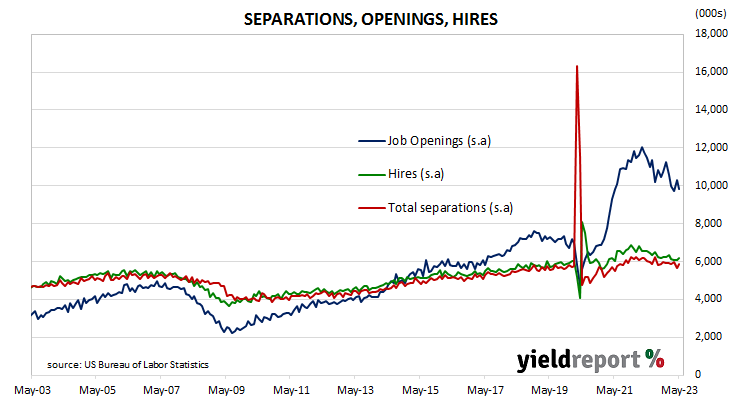Summary: US quit rate rises to 2.6% in May; NAB: higher quit rate suggests increased confidence in labour market; US Treasury yields up; expectations of lower Fed rates in 2024 soften; quits and separations up, openings down; ANZ: quits rate also trending lower.
The number of US employees who quit their jobs as a percentage of total employment increased slowly but steadily after the GFC. It peaked in March 2019 and then tracked sideways until virus containment measures were introduced in March 2020. The quit rate then plummeted as alternative employment opportunities rapidly dried up. Following the easing of US pandemic restrictions, it proceeded to recover back to its pre-pandemic rate in the third quarter of 2020 and trended higher through 2021 before easing through 2022 and early 2023.
Figures released as part of the latest Job Openings and Labor Turnover Survey (JOLTS) report show the quit rate bounced in May after declining for two consecutive months. 2.6% of the non-farm workforce left their jobs voluntarily, up from 2.4% in April. Quits in the month rose by 250,000 while an additional 339,000 people were employed in non-farm sectors.
NAB Head of Market Economics Tapas Strickland said the rise in the quits rate suggested “increased confidence in the labour market.”
US Treasury yields moved higher on the day, aided by ADP payroll and ISM services reports which were stronger than expected. By the close of business, the 2-year had added 5bps to 5.00%, the 10-year yield had gained 10bps to 4.04% while the 30-year yield finished 7bps higher at 4.00%.
In terms of US Fed policy, expectations of a lower federal funds rate in the first half of 2024 softened. At the close of business, contracts implied the effective federal funds rate would average 5.11% in July, 3bps more than the current spot rate, and then increase to an average of 5.295% in August. December futures contracts implied a 5.43% average effective federal funds rate while June 2024 contracts implied 5.035%, 4bps less than the current rate.
ANZ’s Head of FX Research, Mahjabeen Zaman, took a different message from the figures. “The quits rate rose by 0.2% points but is also trending lower, suggesting weaker wage growth ahead.”
The rise in total quits was led by 69,000 more resignations in the “Health care and social assistance” sector while the “Wholesale trade” sector experienced the largest loss, decreasing by 18,000. Overall, the total number of quits for the month rose from April’s revised figure of 3.765 million to 4.015 million.
Total vacancies at the end of May dropped by 0.496 million, or 4.8%, from April’s revised figure of 10.320 million to 9.824 million. The fall was driven by a 285,000 loss in the “Health care and social assistance” sector while the “Professional and business services” sector experienced the single largest increase, rising by 94,000. Overall, 10 out of 18 sectors experienced fewer job openings than in the previous month.
Total separations increased by 211,000, or 3.7%, from April’s revised figure of 5.660 million to 5.871 million. The rise was led by the “Retail trade” sector where there were 113,000 more separations than in April. Separations increased in 11 of the 18 sectors.

The “quit” rate time series produced by the JOLTS report is a leading indicator of US hourly pay. As wages account for around 55% of a product’s or service’s price in the US, wage inflation and overall inflation rates tend to be closely related. Former Federal Reserve chief and current Treasury Secretary Janet Yellen was known to pay close attention to it.


